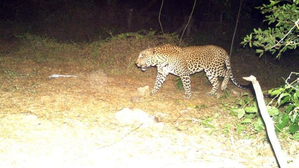Chennai, March 27 (IANS) The Tamil Nadu forest department has installed surveillance cameras and set up cages in Mettur village of Salem district following reports from villagers about leopard sightings and livestock attacks in the region.
Residents and farmers from Mettur and nearby areas such as Vanniyanur, Kaveripuram, and Kathiripatti have raised concerns after a leopard was allegedly seen preying on local livestock, including goats, dogs, and chickens.
Responding to the complaints, forest officials visited the site and, upon examining the animal footprints, confirmed the presence of a leopard behind the recent attacks.
To ensure public safety, forest officials have urged villagers to remain indoors during nighttime hours and to avoid sleeping outside. Special warnings have been issued to children and the elderly. Farmers have also been advised not to take their livestock into forested areas for grazing until the leopard is captured or relocated.
The department has initiated efforts to trap the animal and relocate it to a remote forest area in response to the residents’ demands.
Tamil Nadu has witnessed a notable increase in its leopard population. According to the 2022 census released in March 2024 by the National Tiger Conservation Authority (NTCA), the state recorded a 23 per cent rise in leopard numbers — from 868 in 2018 to 1,070 in 2022. Nationally, the leopard population increased by 8 per cent, from 12,852 to 13,874, during the same period.
Leopards, considered a vulnerable species and an essential part of the ecosystem, are facing growing challenges due to habitat loss, forest fragmentation, and human- wildlife conflict. The NTCA census, conducted in collaboration with the Wildlife Institute of India (WII) and various state forest departments, focused on forest habitats in tiger range states to monitor tigers, co-predators like leopards, prey species, and overall habitat health.
According to the report, more than 65 per cent of leopards in the Western Ghats live outside protected areas, making them more prone to conflicts with human populations. The Nilgiris region was identified as a leopard hotspot, with a density of 13 leopards per 100 square kilometers. The Mudumalai Tiger Reserve (MTR) recorded the highest number of leopards in Tamil Nadu, with 135 individuals, and an additional 220 leopards utilising the reserve area. Sathyamangalam Tiger Reserve (STR) followed with 131 leopards and another 190 using the forest. The Anamalai Tiger Reserve (ATR) came in third with 121 leopards. Other tiger reserves, such as Kalakad Mundanthurai (KMTR) and Srivilliputhur-Megamalai (SMTR), also showed significant leopard presence. KMTR hosts 51 leopards, with 87 more using the area, while SMTR has 97 resident leopards and 147 others utilizing the region.
Tamil Nadu Forest Department officials clarified that the leopard census was part of the 2022 tiger census but was conducted using a distinct methodology suited to estimating leopard populations. The enumeration was not limited to tiger reserves alone but extended to reserve forests across the state.
A senior forest official attributed the growing leopard numbers to improved forest protection, better monitoring systems, and strict anti-poaching measures. Officials also noted that in several regions, tigers and leopards are co-existing without significant conflict, largely influenced by prey availability and forest type.
–IANS
AAL/DPB
Follow Times Report on Google News , Youtube , Whatsapp , Twitter , Instagram and Pintrest for more updates.
